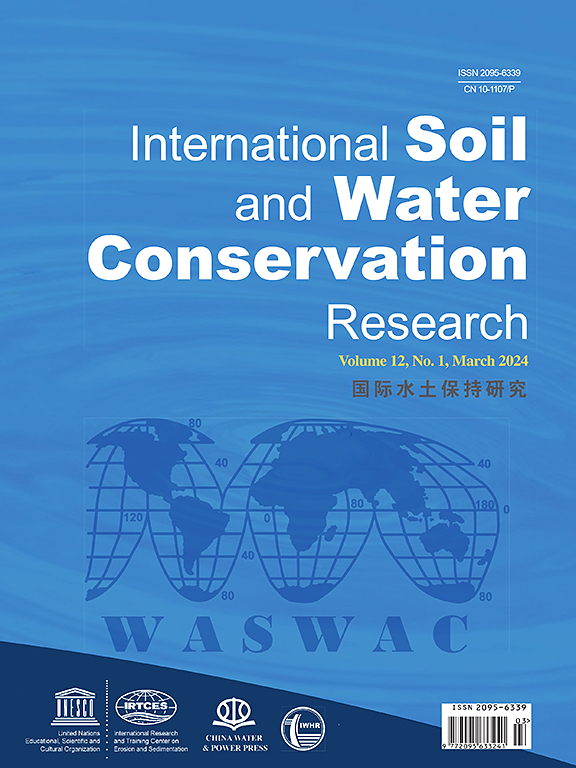Effect of tillage layer depth on erosion driven by surface-subsurface runoff coupling under rainfall simulation conditions
IF 7.3
1区 农林科学
Q1 ENVIRONMENTAL SCIENCES
International Soil and Water Conservation Research
Pub Date : 2025-03-20
DOI:10.1016/j.iswcr.2025.03.004
引用次数: 0
Abstract
The surface tillage layer structure of sloping farmland has a significant impact on rainfall-runoff distribution; however, the relationships between the Tillage Layer Depth (TLD) and surface-subsurface runoff, and the coupling effects of surface-subsurface runoff on soil erosion are still unclear. Thus, a set of laboratory experiments were conducted to reveal impacts of tillage layer depth (10, 20 and 30 cm) on surface-subsurface runoff relationships, eroded sediment processes, and soil erosion pattern evolution under the long-duration (180 min) rainfall simulation tests. A deeper TLD mitigated soil erosion. When the TLD increased from 10 to 30 cm, the average surface runoff decreased by 13 %, subsurface runoff increased by 5 %, and soil loss rate decreased by 19 g m−2 min−1. The interaction between surface runoff and subsurface runoff, influenced by the tillage layer depth, significantly impacts soil erosion. Both surface runoff and subsurface runoff promoted soil erosion at shallow tillage layer depths (10 and 20 cm). Conversely, at TLD 30, the diversion effect of subsurface runoff on surface runoff was enhanced, which played a role in alleviating soil erosion. With the increase of TLD, the soil erosion pattern changed from rill erosion to sheet or splash erosion. During the interill erosion stage, soil loss primarily occurred in the early stage, wherein the Variation Ratio (VR) of soil loss rate and surface runoff coefficient ranged from 2.16 to 4.99. At the rill erosion stage, the VR was approximately 1.0, and the soil loss rate was 2.7- to 6.3- fold greater than that in the interrill erosion stage. These results increase understanding of the effects of TLD on the coupling relationship of surface-subsurface runoff, which is of great significance for alleviating slope farmland erosion.
降雨模拟条件下地表-地下径流耦合驱动下耕作层深度对侵蚀的影响
坡耕地表层耕作层结构对降雨径流分布有显著影响;然而,耕作层深与地表-地下径流之间的关系以及地表-地下径流对土壤侵蚀的耦合效应尚不清楚。因此,在长时间(180 min)降雨模拟试验下,开展了一系列室内试验,揭示了耕作层深度(10、20和30 cm)对地表-地下径流关系、侵蚀泥沙过程和土壤侵蚀模式演变的影响。较深的顶级域减轻了土壤侵蚀。当TLD从10 cm增加到30 cm时,平均地表径流量减少13%,地下径流量增加5%,土壤流失率减少19 g m−2 min−1。地表径流与次地表径流的相互作用受耕层深度的影响,对土壤侵蚀有显著影响。地表径流和次地表径流都促进了浅耕层深度(10和20 cm)的土壤侵蚀。相反,在TLD 30时,地下径流对地表径流的导流作用增强,起到了缓解土壤侵蚀的作用。随着TLD的增加,土壤侵蚀模式由细沟侵蚀向片状或飞溅侵蚀转变。在垄间侵蚀阶段,土壤流失主要发生在前期,土壤流失率与地表径流系数的变异比(VR)在2.16 ~ 4.99之间。细沟侵蚀阶段的土壤流失率约为1.0,土壤流失率是细沟侵蚀阶段的2.7 ~ 6.3倍。这些结果增加了对TLD对地表-地下径流耦合关系影响的认识,对缓解坡耕地侵蚀具有重要意义。
本文章由计算机程序翻译,如有差异,请以英文原文为准。
求助全文
约1分钟内获得全文
求助全文
来源期刊

International Soil and Water Conservation Research
Agricultural and Biological Sciences-Agronomy and Crop Science
CiteScore
12.00
自引率
3.10%
发文量
171
审稿时长
49 days
期刊介绍:
The International Soil and Water Conservation Research (ISWCR), the official journal of World Association of Soil and Water Conservation (WASWAC) http://www.waswac.org, is a multidisciplinary journal of soil and water conservation research, practice, policy, and perspectives. It aims to disseminate new knowledge and promote the practice of soil and water conservation.
The scope of International Soil and Water Conservation Research includes research, strategies, and technologies for prediction, prevention, and protection of soil and water resources. It deals with identification, characterization, and modeling; dynamic monitoring and evaluation; assessment and management of conservation practice and creation and implementation of quality standards.
Examples of appropriate topical areas include (but are not limited to):
• Conservation models, tools, and technologies
• Conservation agricultural
• Soil health resources, indicators, assessment, and management
• Land degradation
• Sustainable development
• Soil erosion and its control
• Soil erosion processes
• Water resources assessment and management
• Watershed management
• Soil erosion models
• Literature review on topics related soil and water conservation research
 求助内容:
求助内容: 应助结果提醒方式:
应助结果提醒方式:


